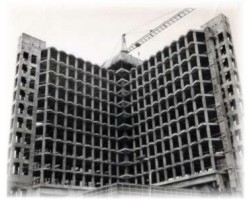|
|
|||||||
|
|
|||||||
 | |||||||
|
|
An Atmosphere of AmicabilitySte. Anne's Hospital enjoyed a good reputation with universities. Students of psychiatry from McGill University came to Ste. Anne's for training, some from as far away as India, Greece and Turkey. There was a great spirit of camaraderie. Some staff members (physicians, nurses, maintenance staff) were veterans themselves as so had special relationships with the patients, having shared the same experiences. The hospital was like one big happy family. During the fifties, there were problems recruiting nurses and dieticians. At that time, women usually quit working when they married, and recruitment was difficult because of the 26 km distance from Montreal. The New Building
The old temporary building had to be replaced and construction started on a new hospital. Treasury Board policy at the time was to transfer federal hospitals to the provincial governments. The hospital was therefore planned so that it could be readily converted into a general hospital to serve the surrounding community. It was even proposed that it be located closer to Montreal, but the final decision was that it remain at Ste. Anne because it suited the disaster plan. Since the hospital was next to the railway tracks and could accommodate helicopter landings, it could serve as a well-equipped, strategically placed hospital to care for the wounded in the event of a disaster in Montreal. Construction got under way in 1968 but a fire occurred even before it was completed. This started in the upper floors and neither the firefighters' ladders nor the water from their hoses could reach it because of insufficient water pressure. The old building had only two storeys and was quite easily accessible even to those in wheelchairs. The new one had thirteen storeys and getting outdoors meant using elevators and travelling longer distances - a minor inconvenience, however, compared to the advantages of the comfortable new building which even had air conditioning. At about the same time, the hospital was reorganized to conform with new concepts of administration. A Changing VocationThe number of patients began to decline, their average age to increase. Negotiations were under way with the Quebec government to transfer Ste Anne's. Finally, the province decided that Queen Mary Hospital suited its needs better. This created certain problems for Ste. Anne's because it no longer had direct access to an affiliated hospital for emergencies. It therefore had to make arrangements with various hospitals for emergency operations and problematical medical cases. As well, it no longer had access to the administrative services Queen Mary had offered, including personnel, finance and purchasing. The 1980s and 1990s have brought about gradual changes to Ste. Anne's Hospital. Fewer people are admitted. The veterans are aging and consequently, the Department of Veterans Affairs is now focussed on delivering excellent services such as the Veterans' Independence Program which provides veterans with a variety of home-care services. The patients have set up highly representative and very active patients' committees. The Department appointed an Ombudsman and residents' rights were of such a concern that, in 1991, the Charter of Patient Rights and Responsibilities was created. In 1992, seventy five years after its inception, the Hospital is home to 725 residents with an average age of 76 years. That year, we celebrated the Hospital's seventy fifth anniversary - the theme is 75 Years of Loving and Caring. In 1998, Ste. Anne's Hospital Foundation was incorporated. Its mandate is to support the advancement of the Hospital, contribute to the patients' quality of life, increase knowledge in the field of geriatrics and support commemoration. Taking a Step Towards Modernizing our FacilitiesThe Hospital was built between 1940 and 1969. As a result, several age-related problems have become increasingly apparent. Furthermore, the buildings no longer meet provincial standards and regulations or the new trends being established for long-term care facilities. In 1993, Public Works and Government Services Canada (PWGSC) issued its first report which conveyed the fact that the buildings' architectural and electromechanical systems needed to be revamped and updated. Capital was invested but only served to mitigate the most urgent problems. In September 2000, PWGSC submitted a report update in which it was stated that the building had seriously deteriorated since 1993. The electromechanical systems and most of the architectural components had reached the end of their lifespan.
Construction Spanning Five years (2003-2007)Work will begin with the construction of a new 130-bed annex specially designed to accommodate patients suffering from cognitive deficiencies. Once the annex is built, major renovations will be undertaken in the main tower. The project involves the restructuring of the living units which includes converting the dormitories into private rooms. Other notable changes will also be made to the living units. The ultimate goal is to create a safe, comfortable and functional environment for the residents and staff. Once the project is completed, there will be 460 beds in the Hospital. The expertise and knowledge of each employee will be drawn upon to make sure that the changes meet and are attune with the patients' needs. To ensure proper follow-ups, Veterans Affairs Canada and PWGSC have established a partnership. Veterans Affairs will manage the project and define patients' needs while PWGSC will serve as a contract agent and will monitor the budget and timetable. By implementing this project, we will be able to draw upon our years of experience in an environment that is better adapted. Specialized Know-How in Treating Post Traumatic Stress SyndromeIn response to an increasing need throughout the county, Ste. Anne's Hospital has started providing specialized services for Canadian Forces members and veterans suffering from mental health problems. We have been working at developing expertise in the field of post traumatic stress syndrome and have established a pilot project in cooperation with the Department of National Defence which was launched on July 3, 2001.
Our centre is called upon to play a key role within the Department's network by recommending national standards for evaluations and treatments, by offering professional clinical leadership, consultation services on the programs we offer and on providing training for staff working in establishments contracted by the Department which are part of the network. Cutting Edge Programs and ServicesAmidst all these projects, we continue to provide cutting edge programs and services. With our unwavering commitment to quality improvement, the Hospital has, within the last few years, consolidated its status of excellence. We are amongst the leaders in several fields including dysphagia, restraint reduction and pain management. Our expanding influence is also due to the growth of our research component. Given the demographics of our country, we are being called upon to take a strategic position in the field of geriatric care administered to Canadians. At Ste. Anne's Hospital, team work and the concept of interdisciplinarity have been tried and tested and are now well ingrained. Many efforts have also been made to maintain a harmonious, positive and inclusive work environment. In 2002, Ste. Anne's Hospital, the last federal hospital administered by Veterans Affairs Canada, is home to about 550 veterans and employs approximately 1200 people. We are very proud to be able to provide Canadian veterans with superior geropsychiatric care, to be focussed on excellence, and to offer state-of-the-art solutions to meet their physical, psychological and social needs. 18/02/1997 |
||||||
|
|
|||||||
 More than twenty years had passed since the end of the Second World War. Changes were necessary. Ste. Anne's was becoming home to increasing numbers of war veterans.
More than twenty years had passed since the end of the Second World War. Changes were necessary. Ste. Anne's was becoming home to increasing numbers of war veterans. There was nothing to do except to let the fire burn itself out which meant that the wooden forms for the concrete were completely destroyed. The old wooden hospital was also threatened as the wind carried sparks everywhere.
Staff members armed with fire hoses wet down the roofs so that the flames would not spread. However, construction was not held up by the fire and, in a well-orchestrated exercise, patients were able to move into the new hospital in 1971.
There was nothing to do except to let the fire burn itself out which meant that the wooden forms for the concrete were completely destroyed. The old wooden hospital was also threatened as the wind carried sparks everywhere.
Staff members armed with fire hoses wet down the roofs so that the flames would not spread. However, construction was not held up by the fire and, in a well-orchestrated exercise, patients were able to move into the new hospital in 1971. On August 1, 2001, we rejoiced as it was announced that $67.7 million had been allocated to renovate our establishment. After several month of feverish preparatory work, we obtained Treasury Board approval. This announcement, made on location at the Hospital by the Honourable Ronald Duhamel, Minister of Veterans Affairs Canada, was one of the most momentous occasions recorded in the Hospital's history books. Now, here we are, ready to forge ahead and begin the rejuvenation process.
On August 1, 2001, we rejoiced as it was announced that $67.7 million had been allocated to renovate our establishment. After several month of feverish preparatory work, we obtained Treasury Board approval. This announcement, made on location at the Hospital by the Honourable Ronald Duhamel, Minister of Veterans Affairs Canada, was one of the most momentous occasions recorded in the Hospital's history books. Now, here we are, ready to forge ahead and begin the rejuvenation process. A year later, on July 3, 2002, the Ste. Anne's Centre was officially inaugurated by the Honourable Rey D. Pagtakhan, Minister of Veterans Affairs Canada and Secretary of State (Science, Research and Development), and the Honourable John McCallum, Minister of National Defence. Since then, thanks to our multidisciplinary team of professionals, we have been in a position to provide our new client base with general mental health services as well as more specialized services for those who have experienced operational stress. Our client base continues to grow proving that there are pressing needs to be met in this particular field.
A year later, on July 3, 2002, the Ste. Anne's Centre was officially inaugurated by the Honourable Rey D. Pagtakhan, Minister of Veterans Affairs Canada and Secretary of State (Science, Research and Development), and the Honourable John McCallum, Minister of National Defence. Since then, thanks to our multidisciplinary team of professionals, we have been in a position to provide our new client base with general mental health services as well as more specialized services for those who have experienced operational stress. Our client base continues to grow proving that there are pressing needs to be met in this particular field.